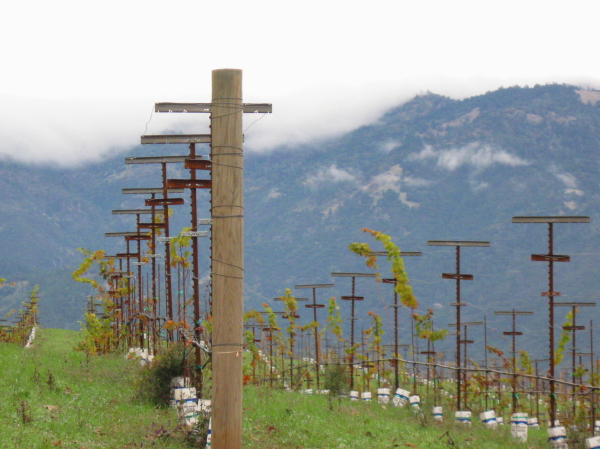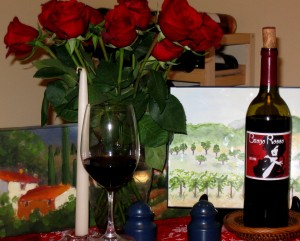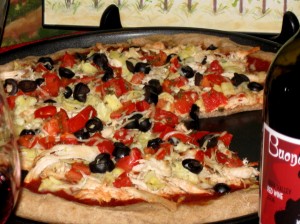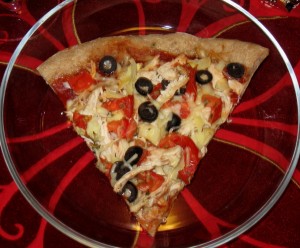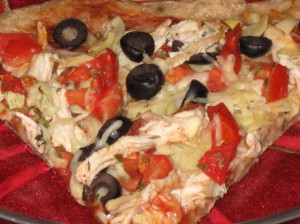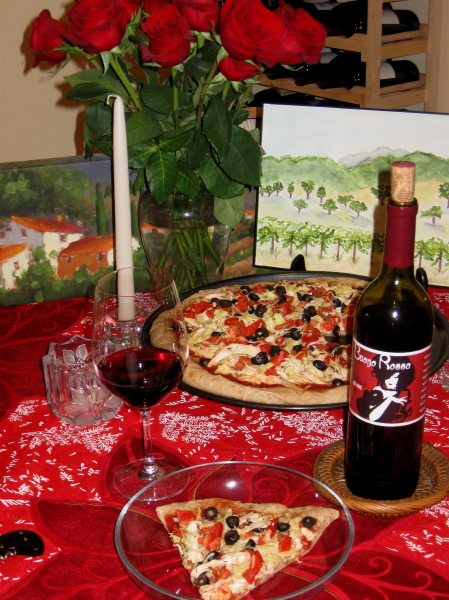Dec 15 2010
A Good Red: The Merits of Red Table Wine
During the month of December, typically rain systems roll down off of the Pacific Ocean to shower on the Bay Area and across to Napa Valley before mustering themselves into snow for the Sierras a few hours to the east. Some years during the month of December, moments of sun can be difficult to catch and seemingly this year falls into this category. Factor in busy schedules whether it is preparing for the holidays with shopping, baking or event attending and already short December days are further clipped.
It is in moments and bouts of weather such as these that simplicity and straight-forward, no-nonsense good quality wine is understandably sought. Enter the red table wine. Red table wine connotes simply what it is supposed to mean, a red wine that belongs on the table any time or any evening. It is designed for casual enjoyment, is likely reasonably priced and often contains the very same grapes that you have grown to love from a winery under a separate label. The fun aspect of investigating wineries’ “red table wines” is discovering a lower-priced option that offers the same estate fruit that you love in a winery’s more expensive offerings, but perhaps in different percentages or blends. This terrific example of when a cheaper wine may sometimes be almost as good as the flagship, separately labeled wine will be rewarding if you are intimately familiar with the winery and its estate grown grapes. Otherwise, it may be an exercise of “hit or miss” in wine selection. This latter possibility is not a cancelling factor either because ultimately all that truly matters is what you the connoisseur (no matter how developed your palate may or may not be) likes.
Clearly this will be meaningful if I use an example of the sought after table wine that is of a better than anticipated quality and pleasantly surprisingly more affordable price point. It is no secret that I am intimately familiar with the wines produced by Benessere Vineyards (“Benessere”). Given that Benessere specializes in Tuscan inspired varietals and goes the extra mile to produce an outstandingly smooth, elegantly structured and balanced wine in all of its varietals, finding a good red table wine at this winery is a terrific treat. Previously bottled under a separate label whose brand invoked thoughts of the “coast and sun”, Benessere’s red table wine emerged under a new label this year as the 2006 blend was released under the winery’s other brand, “Buono Rosso” (meaning, “Good Red” in Italian). Consisting of 46% Sangiovese, 30% Zinfandel and 24% Merlot, this red blend table wine livens any table and surprises the palate with its texture, fruit and embraceable, recognizable structure.
But what makes this Red Table Wine special?
Benessere actually produces award-winning Sangiovese (often recognized as the best Sangiovese in Napa Valley by locals and other wine enthusiasts). Part of the reason its Sangiovese is so outstanding is because the winery grows over 12 different clones of the Sangiovese grape, lending to create an age-worthy varietal which has outstanding complexity. Depending on the Zinfandel grapes used, they are either delicious old vine grapes or grapes used in the winery’s Black Glass Zinfandel (a wine which has received 93 point rating from The Wine Enthusiast). But if these statistics were not enough to pique one’s interest, there is the Merlot. Did you know that Benessere’s estate neighbors Duckhorn Vineyards? And did you know that in the past that Benessere has had a relationship where it has sourced some of its Merlot grapes to same said neighbor? Interested yet? You should be. While other friends are showing up on doorsteps with a certain “decoy” bottle of wine this holiday season, you could arrive with an affordable readily consumable conversation piece.
Opening the bottle of the 2006 Buono Rosso (before the first pour), the nose is greeted with aromas of seasonally festive red fruit such as red plum and cherry. The wine is dark from a distance but at closer inspection the light easily catches along the rim producing eye-catching ruby red jewel tones. Raising the glass to the nose, those previously sensed aromas of red fruit are accompanied by warm aromas of anise spice (or more simply described, black licorice). Like Benessere’s other varietals, this wine is extremely smooth in texture, sprinkled with a lively acidity and ponies up flavorful red fruit as the bouquet promised. For the Merlot lover, it is possible to sense that varietal not just in flavor but also texturally as mid-palate there is a certain fullness best attributed to the Merlot grape’s characteristics. Don’t leave the glass yet: there is a finish on this wine. Yes, a red table wine with a finish. Granted, the finish is simple and shuts down quickly but before your palate thinks that Buono Rosso is done, it will discover a lingering black cherry flavor that has been left behind.
Given that the wine has a present recognizable (yet manageable) acidity, it is no surprise that Buono Rosso will pair well with tomato-based sauces and Italian cuisine. This week’s menu hosts:
· Honey-Whole Wheat Pizza Topped with Grill-Roasted Herbed Garlic Chicken, Garden-Picked Carmelo Tomatoes, Artichoke Hearts and Black Olives
After a week plagued with heavy fog and low visibility, when the sun emerged this weekend for a few afternoon hours, I spared no time in firing up the grill on the back patio. Seasoning chicken breasts with freshly ground black pepper, seasoning salt and lemon thyme picked from the patio, the poultry was sealed in a foil packed with thinly sliced garlic cloves and olive oil. Once roasted on the grill, the undeniably moist chicken was shredded with forks to create a manageable light texture which would continue to roast in the oven on top of the crust. The cloves of garlic also continued to roast until sweet.
Creating a whole wheat pizza crust was an intentional choice as its earthy flavor pairs well with red wine. To sweeten the ensemble, prior to topping, the crust (once stretched across the pan) is drizzled with honey. This flavor brings an unexpected sweetened element to the pizza as a whole but also surprises guests with the deliciously consumable ends of the crust which almost finishes off a slice like a bit of dessert and matches up well with that black cherry finish in the wine.
Topping the crust with a red sauce, the chicken, chopped artichoke hearts and Carmelo tomatoes and sliced black olives makes an already pleasing red wine deliciously zesty. For those who have followed along all summer, you will recall that I seemingly cannot say enough about the Carmelo tomato. An ambassador of sheer goodness, the Carmelo tomato has a unique sugar to acidity balance that simply makes it one of the most flavorfully sweet tomatoes to grace a vine. It boasts a flavor that impresses every diner to rave, “Now THAT is a tomato!”
Black olives top the pizza mainly to diversify appearance and out of personal flavor preference. When taken in conjunction with the wine they seem to accentuate the zinfandel component. Rather than by standard season with basil and oregano, I elected to use marjoram and lemon thyme from the garden so as to promote a sense of sustainability using seasonable fresh herbs in order to liven the flavors of the pizza in a non-traditional way.
The 2006 Buono Rosso is a pleasant easy-drinking wine now but it will age for a few more years. If you can set it aside, the texture will become velvety and other flavors in the wine will become more pronounced. For a 2006 red wine, this is lively and festive, yet easily enjoyable for guiltless quick food pairings or casual entertaining during this busy holiday season.
Comments Off on A Good Red: The Merits of Red Table Wine
